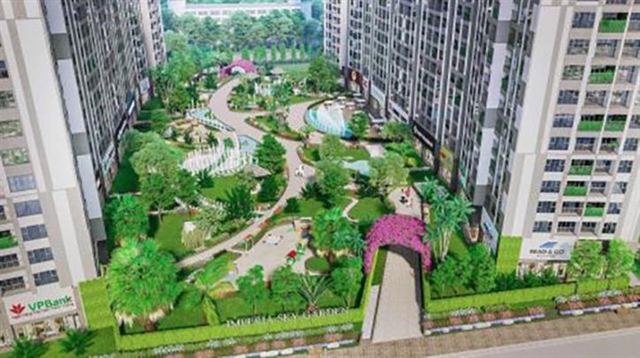Due to the increasing prices and reducing availability of land, many housing projects in HCM City are lowering green space.

Due to the increasing prices and reducing availability of land, many housing projects in HCM City are lowering green space.
The city has witnessed rapid urbanisation and population growth, but has been slow in developing greenery. Public parks only account for 11.75 per cent of its total land area.
According to the Ministry of Natural Resources and Environment, green spaces in large cities are a relatively low two square metres per person, or a 10th of the rate in advanced cities around the world.
In HCM City it is particularly low at 0.5-1sq.m against its target of 6-7sq.m.
To increase the rate, besides building more parks, the city also needs to require housing developers to set aside land for green areas.
Tran Ngoc Chinh, architect and chairman of the Viet Nam Urban Planning and Development Association, said in principle each housing project must have at least 20 per cent of greenery trees, but developers are flouting the rule due to increasing land prices.
Dr Vo Kim Cuong, the city's former deputy chief architect, said the lack of green areas in cities impacts people’s health and the environment.
“It is imperative the public park coverage in HCM City is increased.”
At large housing projects, the construction density should only be 40 per cent, with the rest earmarked for trees and water bodies, but “very few developers in the city can do this,” he said.
Greening trend needs to get serious
Experts said even high-rise projects in the city should pay attention to creating green areas.
Some developers have made financial sacrifices to build parks, and this is being well received in the property market.
A spokesperson for An Gia Real Estate Group said the company was starting to renovate a park situated outside its Westgate complex project in Binh Chanh District with approval from the district People's Committee.
The 2ha park will ensure there are 10sq.m of trees per capita in the project, equivalent to that of the Phu My Hung Urban Area in District 7.
It will also have a lake with landscaping and a tree-lined jogging path.
This park is expected to act as a lung for a radius of about 3km.
Gamuda Land is a developer that earmarks up to 80 per cent of the land area for parks.
Its Celadon City in Tan Phu District has 82ha of green space.
At Nam Long’s Mizuki Park project in Binh Chanh District, more than 70 per cent of the area has been earmarked for green space, water bodies and public utilities.
Besides a 17,000sq.m man-made canal, it has more than 103,000sq.m of trees, a park along the canal, a walking path, and a 2.5km cycling route.
Dennis Ng, general director of Gamuda Land Viet Nam, said developing green space is not only about planting trees but also building an eco-system with diverse landscapes and how to make the most of sunlight, wind and air quality. — VNS





